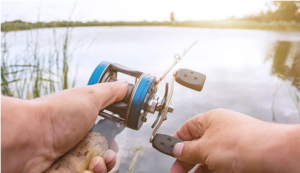Choosing a good fishing rod style can be hard for both beginners and advanced anglers. In today’s market, there are a lot of choices that can cause confusion for potential buyers, but rod styles can be split into two categories: spinning and baitcasting. These types of rods are made to fit their respective rod reel types, which represent different fishing and casting styles. After reading this article, people will have enough knowledge of the world of baitcasting or conventional fishing.
What is baitcasting?
People might be asking themselves, what baitcasting is. Are all rods considered cast baits? That is a very good question. These devices are designed to fit most baitcasting reels; these things are fashioned to mount on top of the rod, and the guide is also aligned with the top of the blank. Individuals should not feel bad if they have been guilty of using baitcasting devices upside down. It is a mistake most beginners commit.
To find out more about reels, click here for details.
The design element will cause the line to put a lot of pressure down the guides, in turn, into the blank when the user is fighting the fish, instead of pulling the guide like with spinning reels. The idea is excellent for fighting heavy and big fishes that anglers might find offshore, like tuna and marlin; there is more shade to baitcasting than this.
These reels also release lines in much tighter patterns compared to spinning reels. It means guides can be a lot smaller, and ultimately casting action is pretty smoother with less drag compared to their spinning reel counterpart. Also, because the orientation of the reel is at the top, the user’s thumb can be used to slow down the release of the line while being used by applying some pressure to the spool.
These features work together to provide users with better casting distance and accuracy. It also presents a very steep learning curve for most beginners. People who have experienced a bird’s nest or rat’s nest while baitcasting know these things too well. Various rod styles are designed for all kinds of fishing in the casting rod classification, from professional bass fishing set-ups to ultra-freshwater outfits to heavy-duty offshore trolling set-ups and everything in between.
Click sites like https://www.bassnedge.com/rods/abu-garcia-ike-signature-power-rod-review/ to find out more about this topic.
Choosing the right baitcasting rod
Now that we all know what baitcasting devices are, as well as how anglers are using them, let’s go to the fun part. So, how do people choose a good rod? Listed below are some significant attributes to help narrow down people’s search for perfect devices for their needs.
Application
The kind of fishing people wish to enjoy is the biggest factor when it comes to deciding on what new device to buy and use. A lot of device manufacturers have adopted this principle, naming and designing rods for niche applications. It makes shopping a trouble-free and easy experience.
The designation could be a general app like saltwater or freshwater. Alternatively, there is a good chance that it is more specific such as rods designed for certain baits, fish species, techniques, or lures. The list is too long to mention certain categories like pitching and flipping, topwater, jigging, offshore, inshore, pier fishing, steelhead, snook, trout, bass, or walleye.

Materials
Spinning and building materials for baitcasters are dominated by two types: fiberglass and graphite. Fiberglass, a pretty durable material, was the standard for many years, but graphite or composites for both materials has been a dominant factor in the industry for many years now.
Graphite is a lot stiffer and more responsive compared to fiberglass, creating fishing devices with greater sensitivity and faster action. These angling rods cast a lot farther, works with lures pretty well, can detect even the slightest of strikes, as well as can put tons of leverage on strong and powerful fishes. Guide materials are also very important and can factor in tons of cost of new devices. People will find them in zirconium, ceramic, titanium, or proprietary materials.
Along with reel seats, the materials used also determine if the rod is suitable for corrosive environments like saltwater angling. Last but not least, and should not be overlooked, people should handle materials in important components to overall fishing stick designs.
These things are built with either Ethylene-Vinyl Acetate foam or natural cork. The most significant difference between the two materials is durability. Ethylene-Vinyl Acetate foams tend to last a lot longer, even without much care. But a lot of anglers prefer the classic feel and look of natural cork.
Attributes: Action, Power, and Length
Action is a measure of how quickly power is being transmitted to the angling rod blank. Extra-fast-action and fast-action sticks transmit power almost instantly. It only bends at the top of the angling stick and is recommended to be used for heavy lures. Medium-action and slow-action fishing devices bend a lot further down the blank. It provides some cushions for using lighter-weight gear. These things are very useful for working and casting lighter finesse live baits and lures.
Power is another important characteristic that anglers need to consider. Power ratings on fishing rods are instrumental when it comes to determining what size reels to pair with rods and, in turn, what weight line they can use. These things range from ultra-light to heavy-duty rods. Most anglers find using the lightest item that can withstand the strength of their target fishes to be the most fun.
Length is an important attribute anglers need to consider when looking for items as it has a huge impact on both accuracy and casting distance, as well as the angler’s ability to fight the species they are angling. Long rods, usually considered any species seven feet or bigger, are excellent for long-distance casting, but it sacrifices the rod’s accuracy. Shorter devices provide pinpoint accuracy when it comes to casting, or in the case of offshore or trolling devices, the power to fight bigger species of fishes and work with heavy baits.



